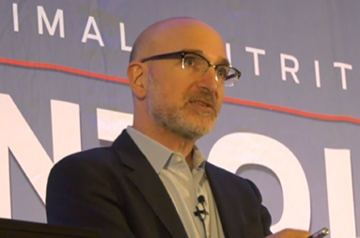
GERONTOLOGY: AN INSIDE OUT PERSPECTIVE
AGING AT A CELLULAR LEVEL
Research is revealing how nutrition can impact aging at the molecular level, from mitochondrial turnover to gene expression. Some of these studies need you!

The Regulation of Mitochondrial Quality Control Via Autophagy and the Scope for Pharmaceutical and Nutraceutical Approaches
Michelangelo Campanella Pharm D, PhD, MRPharmS, PGCAP, FHEA, FRSB
University of London Royal Veterinary College, University College London Department of Cell and Developmental Biology Consortium for Mitochondrial Research, London, U.K.
Overview
Mitochondria are vital organelles that play key roles in energy production and cell death, thereby influencing cell fate. In healthy cells, the removal of damaged mitochondria is closely regulated via the catabolic process of targeted autophagy, called mitophagy. Abnormalities in mitochondrial regulation lead to many age-related diseases, such as Parkinson’s disease. Overabundance of mitochondria is linked with longevity. In this presentation, Campanella describes how regulation of mitophagy is linked with dietary lipids through a mitochondrial translocator protein, TSPO. The availability of lipids can influence mitochondrial regulation and, in turn, systemic health.

Premise of Systems Microbiomics in Improving Health and Related Diagnostics for Human and Companion Animals
Sunil Kochhar PhD
Nestlé Research Center, Lausanne, Switzerland
Overview
Systems microbiomics creates a comprehensive profile of an individual’s metabolome and microbiome. Defining the “metabotype” of individual people or companion animals offers an opportunity to evaluate the metabolic response, and the degree of this response, to specific dietary changes at the individual level. Kochhar describes how system microbiomics provided a valuable tool to study aging in a long-term study of dogs in which caloric restriction (CR) of energy intake, without malnutrition, was shown to prolong life and delay age-related morbidity.

The Dog Aging Project: Can Old Dogs Teach Us New Tricks?
Daniel E.L. Promislow DPhil
University of Washington, Departments of Biology and Pathology, Seattle, WA USA
Overview
Veterinarians readily recognize dogs that are aging well, or poorly, but there is currently no standardized way to document these observations and share them with colleagues. This presentation describes the Dog Aging Project (DAP), which will take advantage of the extraordinary variation in domestic dog breeds to identify the genetic and environmental factors that shape health span and lifespan. With a planned cohort of 10,000 companion dogs, this longitudinal study of aging and age-related disease will help develop tools to improve the description, and ultimately the care, of aging dogs.

Using Genomic Biology to Study Pet Aging
Kelly S. Swanson PhD
University of Illinois, Urbana, IL USA
Overview
30-40% of the pet population are seniors and, like humans, the physiological changes of aging increase the risk of chronic disease development. This presentation covers advances in genomic biology and technology that can help increase understanding of the aging process, identify mechanisms by which age-related illnesses occur, and design more targeted prophylactics and/or therapeutics.

Searching for Nutrition Targets: Multi-Omics Study in Early-Stage Myxomatous Mitral Valve
Johnny Li PhD
Nestlé Purina Research, Saint Louis, MO, USA
Overview
Myxomatous mitral valve disease (MMVD) is the most common acquired heart disease in dogs and the incidence increases with age. There is no treatment for this common form of heart disease and later stages of MMVD can lead to congestive heart failure. Previous studies have looked at late-stage disease, but it is important to look at the early stages when dogs are not yet symptomatic. This presentation describes the transcriptomics and metabolomics that Purina scientists used to identify key metabolic and molecular pathways to better understand the development of MMVD.
This document contains summaries of all presentations from the Companion Animal Summit, held May 3-5, 2018 in Charleston, South Carolina. Please note that these summaries represent overviews of the presentations and may include opinions and research of presenters, which do not necessarily reflect those of the Nestlé Purina Petcare Company.
Produced by the Purina Institute, May 21, 2018
Speakers

Michelangelo Campanella
Pharm D, PhD, MRPharmS, PGCAP, FHEA, FRSB
The Royal Veterinary College, UCL Consortium for Mitochondrial Research



Kelly S. Swanson
PhD
Univ. of Illinois, Dept. of Animal Sciences, Div. of Nutritional Sciences

Related content


